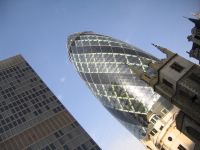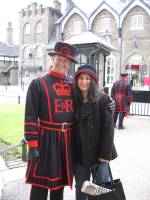Tales of Brave Ulysses
What began as a travel blog has turned into a random journal of law school and other experiences, and a "bully pulpit" for commenting on the world around me. Comments welcome.
Tuesday, March 22, 2005
Saturday, March 19, 2005
Back to London
We returned to London about 4:30 with no plans for our last night in town. We the Jack the Ripper walking tour, but we were also tired of walking and decided to just go eat somewhere. We asked the concierge where we should go and he told us there were some restaurants about 15 minute walk from the hotel. He was wrong! It was only a few pubs full of teenagers. We took the tube to Covent Garden and had a nice dinner, then wandered around the area some. We found a cellar bar called Punch & Judy. Since it's a cellar bar, the walls are all bricked up and there are no windows. It sounds like it would be a claustrophobe’s nightmare, but it was pleasant enough and we enjoyed sitting down for a while.
Leeds Castle & Sheep!

 |  |
 |  |
 On the walk back to the bus, Nora spied sheep in a neighboring field. Sheep, at 200 yards! A number of them lay in the shade under some trees near the fence line. Though we were short on time and our feet sore from days of walking, we hobbled / jogged over to where the sheep were. Some of them looked at us warily as we approached, and a few ran off. Some stayed, though, and we got a few good pictures.
On the walk back to the bus, Nora spied sheep in a neighboring field. Sheep, at 200 yards! A number of them lay in the shade under some trees near the fence line. Though we were short on time and our feet sore from days of walking, we hobbled / jogged over to where the sheep were. Some of them looked at us warily as we approached, and a few ran off. Some stayed, though, and we got a few good pictures.
Friday, March 18, 2005
What, no comments?
OK, come on. No one commented on us seeing the Queen?
We don't have much time now but later I'll blog about Henry VIII's ornamental gardens, the college town of Oxford, historic Runnymeade, Sir Winston Churchill's grave in Bladon, Shakespeare's birthplace in Stratford-on-Avon, the villages of the Cotswold Hills, the Wye valley in Wales, the Roman baths in Bath, Stonehenge, the town of Arundel and the castle of the Duke of Norfolk (my ancestors, the Howards), and the city of Brighton.
Update: Obviously since writing this I have made good on my promise! :o)
Stonehenge & Salisbury

 Much has been written about Stonehenge, and I will leave it to you to read more if you wish. I have to agree with Bill Bryson that Stonehenge is a great place to visit, but after about 15 minutes of staring at the rocks and trying to imagine the men who put them there, your mind starts to wander and you wonder if you can get fish & chips near the gift shop. Now me, I opted for a brick of bread pudding. In the gift shop they sell the same rubbish that you’ll find in any gift shop anywhere in the world. Mugs, t-shirts, miniature Stonehenges. (All I could think of when I saw those was Spinal Tap’s Stonehenge model where they pulled a NASA and got their units of measure confused, with hilarious results). And oh yes, you can buy commemorative Stonehenge socks. No kidding.
Much has been written about Stonehenge, and I will leave it to you to read more if you wish. I have to agree with Bill Bryson that Stonehenge is a great place to visit, but after about 15 minutes of staring at the rocks and trying to imagine the men who put them there, your mind starts to wander and you wonder if you can get fish & chips near the gift shop. Now me, I opted for a brick of bread pudding. In the gift shop they sell the same rubbish that you’ll find in any gift shop anywhere in the world. Mugs, t-shirts, miniature Stonehenges. (All I could think of when I saw those was Spinal Tap’s Stonehenge model where they pulled a NASA and got their units of measure confused, with hilarious results). And oh yes, you can buy commemorative Stonehenge socks. No kidding.There is also a city of Salisbury, and a Gothic cathedral wherein you can see the grave and effigy of a cousin of mine, William Longspee, who was a son of Henry II and died in 1226. The cathedral also houses one of the remaining copies of the Magna Carta. (And where was it signed? That’s right, Runnymede. Just seeing if you were paying attention.)
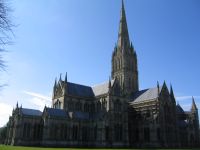

Thursday, March 17, 2005
Scenic Countryside
Today we drove through a pastoral region called the Cotswold Hills, where a number of small, quaint villages lie. We drove through Broadway, Cheltenham and Gloucester on our way to Wales. Wales is considered a different country from England, and of the four (England, Ireland, Scotland and Wales) it’s probably Wales that gets the least press. Quick, what do you know about Wales? What imagery does it conjure up for you? For most Americans, I can tell you what the answer is: if anything, it’s that Charles is the Prince of Wales. Beyond that, probably very few even have a clue. That’s too bad because Wales is a lovely area. We saw the with lush fields of the Wye Valley and the majestic ruins of Tintern Abbey.
 Tintern Abbey was founded by Cistercian monks in 1131, far away from everything. It was the first Cistercian foudation in Wales, and only the second in Britain. It survived for just over 400 years, until Henry VIII dissolved the Catholic monestaries and, well, robbed them of their wealth in 1536. After that, it began to fall into disrepair. The roof collapsed, and farmers would take stones from the remains of the abbey to use in their building projects. Now it is maintained by Cadw, the Welsh preservation agency. Today all that remains is a ruin of quiet majesty and a reference in the title Wordsworth’s ponderous pastoral poem. (My high school English teacher loved it, but I didn't have the patience for it then or now!)
Tintern Abbey was founded by Cistercian monks in 1131, far away from everything. It was the first Cistercian foudation in Wales, and only the second in Britain. It survived for just over 400 years, until Henry VIII dissolved the Catholic monestaries and, well, robbed them of their wealth in 1536. After that, it began to fall into disrepair. The roof collapsed, and farmers would take stones from the remains of the abbey to use in their building projects. Now it is maintained by Cadw, the Welsh preservation agency. Today all that remains is a ruin of quiet majesty and a reference in the title Wordsworth’s ponderous pastoral poem. (My high school English teacher loved it, but I didn't have the patience for it then or now!) 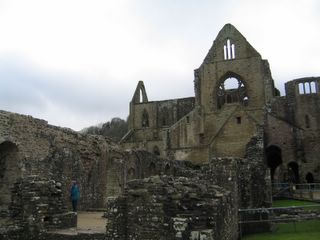

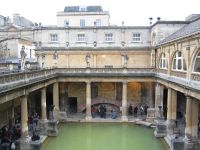 After this, we rode back to England and on to the city of Bath. Bath is so named for the Roman baths. Apparently the Romans discovered a hot spring in western England and turned it into a resort town. They built up ornate buildings around the springs. When the Anglo-Saxons took over, they had no use for bathing(!) so the area fell into disuse. The area is sunk into the ground but has been pretty well excavated, and as you descend into the area where the springs are you can feel the heat radiating from the water. There is an impressive Abbey next to the entrance to the baths.
After this, we rode back to England and on to the city of Bath. Bath is so named for the Roman baths. Apparently the Romans discovered a hot spring in western England and turned it into a resort town. They built up ornate buildings around the springs. When the Anglo-Saxons took over, they had no use for bathing(!) so the area fell into disuse. The area is sunk into the ground but has been pretty well excavated, and as you descend into the area where the springs are you can feel the heat radiating from the water. There is an impressive Abbey next to the entrance to the baths.



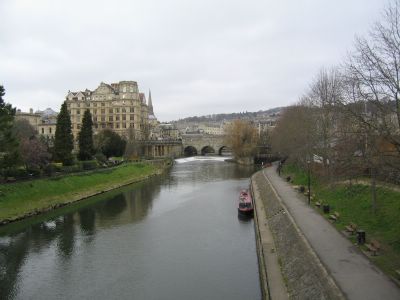
Brighton Beach Memoir
On the drive to Brighton we could see the white, chalky cliffs along the southern coast. Not the famous white cliffs of Dover, mind you, but still nice to see. A cold, heavy fog descended on Brighton just before we arrived and obscured out view of the English Channel.
The main attraction in Brighton was the Royal Pavilion built for the Prince Regent who would become George IV over the period 1815-1823. It’s one of the stranger buildings I’ve seen. On the outside it looks like it’s got Indian influence and on the inside it’s Chinese. That’s right—an Indian/Chinese palace in Brighton.
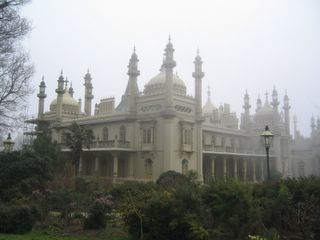 And it looks as out of place as it sounds. Our guide told us either we would love it or hate it, and I’m one of those in the second category. The music room had motifs with snakes and dragons, which our guide told us brings bad luck according to Chinese feng shui. I have no idea if that’s true, but the building has suffered a number of mishaps. The roof started leaking within 10 years of completion. In 1975 a fire bomb was thrown into the music room, causing major damage. It took years to repair. Then in 1987 a storm knocked down one of the heavy domes and it toppled, crashing through the roof into the music room and embedding itself in the floor. But if a building exists for hundreds of years, hey, these things will happen. Um, right?
And it looks as out of place as it sounds. Our guide told us either we would love it or hate it, and I’m one of those in the second category. The music room had motifs with snakes and dragons, which our guide told us brings bad luck according to Chinese feng shui. I have no idea if that’s true, but the building has suffered a number of mishaps. The roof started leaking within 10 years of completion. In 1975 a fire bomb was thrown into the music room, causing major damage. It took years to repair. Then in 1987 a storm knocked down one of the heavy domes and it toppled, crashing through the roof into the music room and embedding itself in the floor. But if a building exists for hundreds of years, hey, these things will happen. Um, right?Parts of Vanity Fair were filmed in Brighton.
Arundel
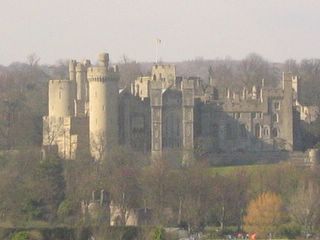
Wednesday, March 16, 2005
Stratford-on-Avon

 From Bladon we drove on to Stratford-on-Avon, another small town with but one claim to fame. William Shakespeare, as every high school student knows, was born in Stratford-on-Avon, and he retired and died there. The powers that be have preserved / restored the house where Shakespeare was born, and the house where lived Anne Hathaway, whom Shakespeare married. There are guides who describe the techniques used by John Shakespeare in his glovemaking business, and upstairs you can see the room where, they say, the Bard of Stratford was born. They have tried to deck out the place with period furnishings, but as an historian I am perpetually skeptical of modern recreations. After all, it’s not as if the place was immediately enshrined and frozen in time. What we see today is what it might have looked like—an artist’s rendering of what might have been, and nothing more. All of that did little to dampen the excitement of walking through the town that Shakespeare called home.
From Bladon we drove on to Stratford-on-Avon, another small town with but one claim to fame. William Shakespeare, as every high school student knows, was born in Stratford-on-Avon, and he retired and died there. The powers that be have preserved / restored the house where Shakespeare was born, and the house where lived Anne Hathaway, whom Shakespeare married. There are guides who describe the techniques used by John Shakespeare in his glovemaking business, and upstairs you can see the room where, they say, the Bard of Stratford was born. They have tried to deck out the place with period furnishings, but as an historian I am perpetually skeptical of modern recreations. After all, it’s not as if the place was immediately enshrined and frozen in time. What we see today is what it might have looked like—an artist’s rendering of what might have been, and nothing more. All of that did little to dampen the excitement of walking through the town that Shakespeare called home. In the evening, our tour group met for dinner and drinks. We chatted with some of the other tourists. This time everyone was from an English-speaking country: the US dominated, but there were a few Canadians, Australians, and a New Zealander. In England, shops close around 5:00 or 6:00 and there wasn’t much to do after dinner, so we took a walk around Stratford. It’s small—-you can circumnavigate the town in about an hour.
In the evening, our tour group met for dinner and drinks. We chatted with some of the other tourists. This time everyone was from an English-speaking country: the US dominated, but there were a few Canadians, Australians, and a New Zealander. In England, shops close around 5:00 or 6:00 and there wasn’t much to do after dinner, so we took a walk around Stratford. It’s small—-you can circumnavigate the town in about an hour. I think it was somewhere on the drive to Stratford-on-Avon, as we passed the gentle rolling hills dotted with the wandering sheep, that Nora started to get the urge to get an up-close picture of a sheep. It turned into something of a quest, and it would be several days before we were able to get one, for while the sheep were ubiquitous, none wandered very near to the fences by the roads.
Churchill
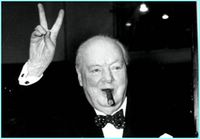
I expect that the Battle of Britain is about to begin. Upon this battle depends the survival of Christian civilization. Upon it depends our own British life, and the long continuity of our institutions and our Empire. The whole fury and might of the enemy must very soon be turned on us.If only our current President were half as erudite!
Hitler knows that he will have to break us in this Island or lose the war. If we can stand up to him, all Europe may be free and the life of the world may move forward into broad, sunlit uplands. But if we fail, then the whole world, including the United States, including all that we have known and cared for, will sink into the abyss of a new Dark Age made more sinister, and perhaps more protracted, by the lights of perverted science.
Let us therefore brace ourselves to our duties, and so bear ourselves that if the British Empire and its Commonwealth last for a thousand years, men will still say, 'This was their finest hour.'
- Speech to House of Commons, June 18, 1940.
Oxford
Later, we drove through Runnymede, where King John signed the Magna Carta, on our way to Oxford, where we had lunch and watched the students roaming about. Oxford isn’t one large campus in the city like we would think of in the US; rather, it’s a collection of many smaller campuses clustered together. Colleges are separate buildings with lush courtyards.
Hampton Court Palace

Our road trip of southern England began with a drive to Hampton Court Palace. It was used pretty extensively by the royals form the mid-1500s to 1700s, so there is a great deal of history on these grounds. Henry VIII’s ill-fated son Edward was born here in 1537. Henry’s wife, Jane Seymour, died here days later. Here Henry learned of the infidelities of Catherine Howard. Here James I held his Hampton Court Conference in 1604, which led to the King James authorized version of the Bible. Here Charles I was held prisoner for there months by Oliver Cromwell in 1647. Sadly, in 1689 King Willliam III had architect Christopher Wren tear down Henry’s old lodgings and the courtyard to make room for a more modern design, so much from those days has vanished. In 1702, soon after William finished his renovations, he fell while riding his horse in the park here and died soon after. I won’t be superstious and blame Henry’s ghost.
 |  |
 | 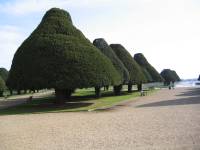 |
 |  |
Tuesday, March 15, 2005
We saw the QE2! No, not the ship!
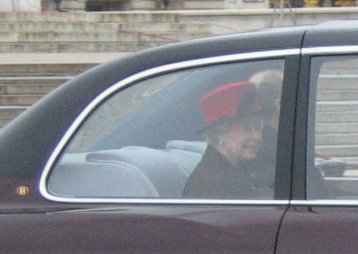
Is it good luck when the Queen crosses your path?
Today officially started the tour as we joined the bus group for a drive around London. As I had predicted to Nora, there are only a few demographics involved. We have the newlyweds (10%), the mothers and daughters (10%), the seventysomethings (75%), and a few Lone Rangers like me (5%). You're right, there are less than 100 people on the tour; these numbers are estimates, don't you know.
We drove by the Royal Albert Hall, the concert hall that the Beatles mentioned in a song. We saw a church with one side pockmarked from the blitzkrieg of World War II, the scars left as a reminder of those dark days. We visited St. Paul's Cathedral and toured the inside. Lord Nelson is buried there. Sorry, no pictures are allowed inside any of the churches. St. Paul's is where Charles and Diana were married, and I recognized it from the Royal Wedding on TV.
After that we rode to Buckingham Palace, where we hoped to see the changing of the guard. Traffic was unusually heavy in the area, and there was a strong police presence. Our tour guide asked a policeman what was happening. Silvio Berlusconi, president of Italy, was coming for a state visit. We couldn't drive there, but we could walk. So everyone disembarked to go see what we might see. Outside Buckingham Palace, the road makes a circle and then a long street that leads away from the palace. The sides of the road were lined with British and Italian flags. Police and palace guards stood at various points along the road, and a barrier was set up to keep the growing crowds back. A pair of horsemen wearing parade helmets went by, then nothing for several minutes. Cannons fired, then silence. After a few minutes, a procession of motor cars emerged and drove slowly around the circle, then in front of us, and away. Inside the lead car we could clearly see Queen Elizabeth II sitting in the back seat, on her way to greet the President. (Yes, I got a picture! It reminded me of that camera commercial with Steven Tyler where, um, nevermind....) Thirty minutes later she returned in a procession of horse-drawn carriages, but we couldn't see her as well.
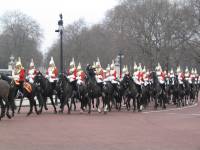



 We walked down to Big Ben and Parliament, then followed the Thames to the Globe Theater, meant to be an accurate replica of Shakespeare's Globe. Inside there were children from Southwork schools practicing a scene from Macbeth ("Out, damed spot!") then we saw the Golden Hind (Sir Francis Drake's ship from the 1500s), and then a play by the Reduced Shakespeare Players on the Complete History of America.
We walked down to Big Ben and Parliament, then followed the Thames to the Globe Theater, meant to be an accurate replica of Shakespeare's Globe. Inside there were children from Southwork schools practicing a scene from Macbeth ("Out, damed spot!") then we saw the Golden Hind (Sir Francis Drake's ship from the 1500s), and then a play by the Reduced Shakespeare Players on the Complete History of America.So let's see. We toured London, saw St. Paul's, Big Ben, and oh yes, the Queen. We saw an historic ship and an historic play in an historic setting, followed up with an historically themed comedy. All in all, not bad for a Tuesday!
P.S. Yes, yes, we also saw the President of Italy, I suppose. What does he look like again? I think he was driving the chariot... :-P
Lincoln & The Tower of London

On our first full day in London we started out with the included breakfast. The Hilton Metropole offers a very good breakfast if you can get past the perpetually cold scrambled eggs. Most of the dishes are exactly what you would expect, but the bacon is really sliced ham. Just so you know!
Since the hotel charges an outrageous price equating a dollar a minute, we went down to the pay phones to call up a former coworker who works in London. We told him we were in town and we were coming by. We took the tube to Old Street (nothing touristy about it) and met up with Lincoln. I would like to say he hadn't changed at all in the past six months, but that would be a lie. Lincoln is from Texas, same as me, and attended the University of Texas at Austin. So when I started hearing him use words like "a proper meal" or "have you not heard of the walk-in program?" or "Take your rubbish with you because there are no bins here," well, I'd say the city has begun to sink in.
Of course, Lincoln's not to be blamed, really. London is a monster of a city, with a population of about nine million souls, and almost no one, it seems, is a native Londoner. Why, in one random gift shop the person in queue before us began telling the man at the register how they were from Texas--as were we--as were the two people in line behind us. Small world indeed.
 We found a restaurant and ordered traditional English fare, then Lincoln took us on a snipe hunt through London for the perfect pub. We walked all the way down to Trafalgar Square and then he told us he needed to get home and bailed. Thanks, Lincoln! Great to see ya! Well, only kidding. It was great to chat with him, catch up on things, and hear the perspective of a transplanted American living in London.
We found a restaurant and ordered traditional English fare, then Lincoln took us on a snipe hunt through London for the perfect pub. We walked all the way down to Trafalgar Square and then he told us he needed to get home and bailed. Thanks, Lincoln! Great to see ya! Well, only kidding. It was great to chat with him, catch up on things, and hear the perspective of a transplanted American living in London.Exhausted as we were by the day's walking, we decided to turn in and rode back to the hotel for some sleep.


